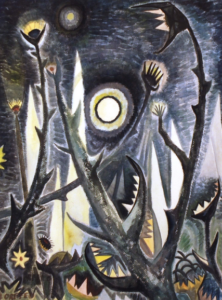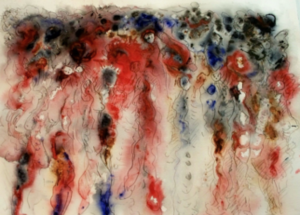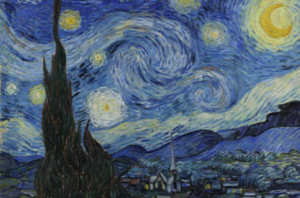Return to Series Table of Content / Return to VJIC Table of Content
“The aim of art is not to represent the outward appearance
of things, but their inward significance.” — Aristotle
Look around. Everything is real, right or is it not? We can see, hear, touch, smell and often taste the things around us. So, we know those things are there. It seems crazy to question reality. But that’s exactly what scientists and philosophers are doing. From the smallest (quantum mechanics) to the largest (cosmology) to the deepest (philosophy) the reality of things is in doubt. Could everything be all in our head(s)? Embracing this enigma leads to art and the way we interact with it.
Let’s start with the smallest. Niels Bohr, one of the founding fathers of quantum physics established the concept of complementarity. His view of reality means that “neither particles nor waves are attributes of nature. They are no more than ideas in our minds which we impose on the natural world.” [Les Smolin, Einstein’s Unfinished Revolution]. In Bohr’s view reality is something created by us, in our minds.
Next, let’s go to the largest with Sir Isaac Newton. “I do not know what I may appear to the world, but to myself I seem to have been only like a boy playing on the seashore and diverting myself in now and then finding a smoother pebble or a prettier shell than ordinary, whilst the great ocean of truth lay all undiscovered before me.” So, Newton saw reality as something we don’t yet know, but something that we have an opportunity to discover.
Back in the eighteenth-century Immanuel Kant provided valuable insight regarding the shortcoming of our senses: “…our rational cognition applies only to appearances, and leaves the thing in itself unrecognized by us, even though inherently actual.” He pointed-out that we can only perceive vibrations bouncing from the surface of things. We never perceive “the thing in itself.”
And even those vibrations are questionable indicators. The color red, for example, doesn’t exist in the vibrations, or in reality. The vibrations are interpreted in our minds where “red” is created (also language has other ways noting the interpretation of the stimulation: roja, το κόκκινο, nyekundu.) Now think about the fact that everything we know is an “interpretation” of vibrations accumulated through sense organs and blended into our perception of the reality around us. …seems like it is “all in our head(s).”
So, our search for the truth of reality goes beyond the obvious feedback we get from our limited sense organs (i.e., ears; eyes; nose; touch/skin; taste/tongue). The universe is far greater and more complex than can be determined with these tools. However, our senses do provide a way to pursue our search as the tools evolve.
Now to philosophy. Let’s start with Aristotle, “The soul never thinks without a picture.” Through art our senses provide signals that permit our mind/soul to partially overcome the limits of our senses. It requires more than simply seeing or hearing – it takes connection to whatever it is inside us that not only receives the vibrations but finds meaning there. Some of us see the vibrations from visual art and interpret them literally. We simply see a tree, a person or a blotch of color and shapes, etc. For others, the vibrations unlock deeper insight which links us to the emotion of the artist. Likewise, music touches the soul. Some hear the music of Miles Davis (https://www.youtube.com/watch?v=zqNTltOGh5c) and cringe at hearing a literal sequence of notes and pauses. Others are transported into his soul and cry at the depth of emotion this man was able to communicate with his horn.

© Joe Orffeo
And “Jean-Paul Sarte went farther, noting that life itself is drained of meaning ‘when you have lost the illusion of being eternal.’” [Brian Greene, Until the End of Time]. Sarte captured the angst we feel in our lack of knowing the nature and the fate of the universe, and, of course, ourselves. In my view he erred by adopting atheism instead of agnosticism. As of now, all we can really say is ‘we just don’t know.’ And art is a way of probing the seemingly impenetrable barrier to real understanding.
Think about the way we learn. We use metaphor as a primary tool. When we experience new things, we compare them to things we’re already familiar with. Early on we learn arithmetic largely through our familiarity with our fingers. In fact, that’s the reason our math system is base ten. So, our search for ultimate (and elusive) understanding of the universe and its meaning is also tied to metaphor – in this case, art.
Personally, I link abstract art with meditation. Successful meditation requires an ability to block out all the “noise” in our mind and focus strictly on the “now.” Zen koans are unanswerable questions that ease the mind into a meditative state (i.e., what’s the sound of one hand clapping). It’s claimed that this state allows a clearer connection to the universe that’s typically screened out by the “noise” of everyday experience.
Geniuses, including artists, seem to be able to form a connection with something beyond the mundane world. They are often able to capture symbols and/or sounds that present insights that inspire us. An artist friend of mine, Joe Orffeo, was commissioned to produce a painting symbolizing our chaotic society. As you view this watercolor, you’re likely more influenced by the feeling it inspires rather than the details of the images.

© Joe Orffeo, Social Chaos
Neil DeGrasse Tyson’s analysis of Van Gogh’s Starry Night is another example of our point. “What I like about it is it’s clearly not exactly what he (van Gogh) saw cause the sky doesn’t do that. But it’s no doubt what the sky felt like to him. And for me art at its best captures the emotion of reality rather than the reality (we see). If I want reality, I’ll take a picture.”
And there’s also a hypothesis among mathematicians/physicists that Starry Night answers a mystery in fluid dynamics. “As difficult as turbulence is to understand mathematically, we can use art to depict the way it looks … in the Starry night his circular brush strokes create a night sky filled with swirling clouds and eddies of stars. Several scientists “…studied the luminants in Van Gogh’s painting in detail. They discovered that there is a distinct pattern of turbulent fluid structures close to more current mathematical equations hidden in Van Gogh’s painting.” [Ted Talk, see references]

© Vincent Van Gogh, Starry Night
And now to the Whiteness of the Whale. Newton saw “…the great ocean of truth…” as he looked toward the ocean’s horizon and his mind soared beyond. Likewise, Ishmael {Melville] sought truth in the ocean. “If they but knew it, almost all men in their degree, some time or other, cherish very nearly the same feelings towards the ocean with me.” And Ahab was driven to find truth (in his case evil truth) symbolized by the white Moby Dick who removed his leg on a previous encounter. This is my favorite metaphor involving the search for truth. Ishmael finds himself depressed with life and is filled with the need to search for meaning: “Whenever I find myself growing grim about the mouth; whenever it is a damp, drizzly November in my soul … I find it high time to get to sea as soon as I can.” *** did I mention that the whale was fighting evil ? Ahab represented evil as he was the hunter and destroyer.
He took to the sea (the unknown) in search of truth. In this metaphorical novel the white whale symbolized dangerous truth that spelled death for all but Ishmael. Melville hints that this kind of search should be avoided, if possible. Here again, he is using art to form a bridge to the unknown. He uses the color white as a strong symbol (omen). “The elusive quality it is, which causes the thought of whiteness, when divorced from more kindly associations, and coupled with any object terrible in itself, to heighten that terror to the furthest bounds.” [this going on two centuries before BLM]
In the final analysis our senses are too feeble to grasp the nature of reality. Yet, the perceptions they provide are so strong that we tend to think we have a true picture. In fact, we know nothing. This is coupled with an aspiration existing in humanity as a whole to seek the answer. Many of the geniuses who feel this drive are called artists. Melville used the ‘whiteness of the whale’ as a symbol for the unseen turbulence that existed inside. This was Melville’s artistic method for warning us of the danger that lies in seeking an understanding of ultimate truth. Was he right? Or instead of evil, is white the ultimate good?
Les Smolin: https://www.penguinrandomhouse.com/books/316818/einsteins-unfinished-revolution-by-lee-smolin/
Tyson, Starry Night: https://www.youtube.com/watch?v=0nBMyj-r92A
Van Gogh: https://www.youtube.com/watch?v=PMerSm2ToFY
